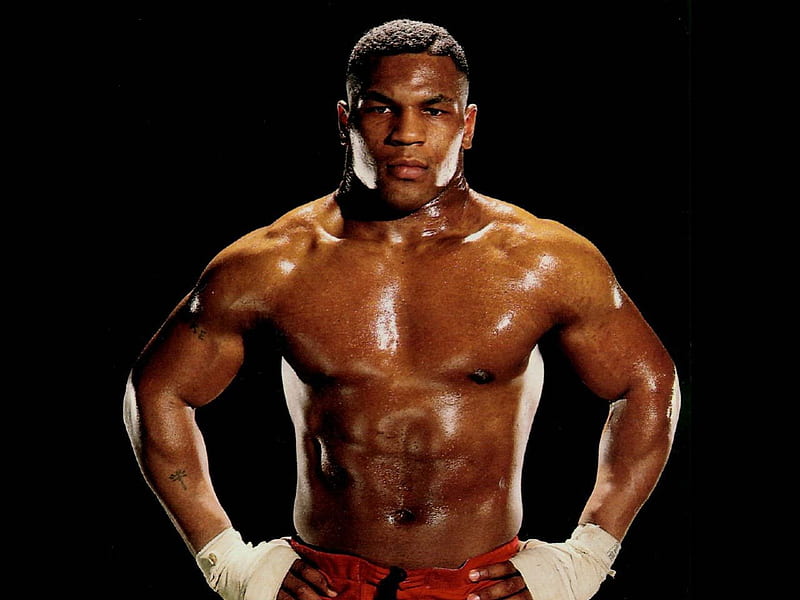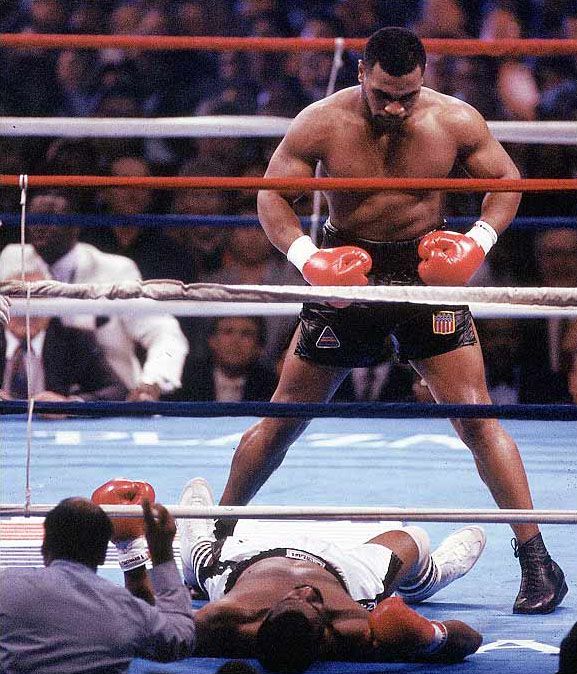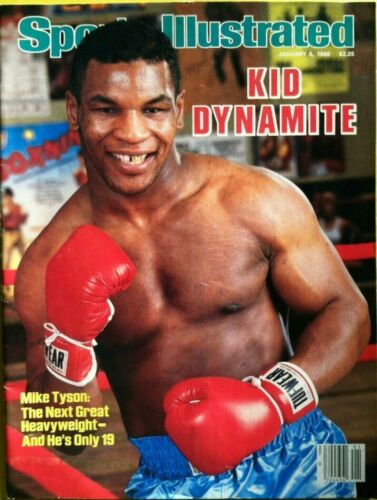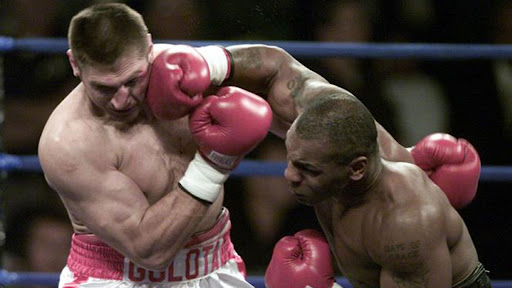

The image is one of opposing contrasts. The self-proclaimed baddest man on the planet, an aggressive, unstoppable force, destroying everyone in his path on his way to becoming the undefeated, undisputed, unified heavyweight champion of the world.
The other is a fighter on his knees, groveling for his mouthpiece, beaten, upset by a 42-1 underdog.
Mike Tyson (50-6, 44 ko’s) may be the most overrated heavyweight champion by casual boxing fans and the most underrated heavyweight champion in history by serious boxing aficionados. When Mike first appeared on the scene in the 1980s it seemed like the world had not seen his like since the heyday of Jack Dempsey. After his upset defeat at the hands of Buster Douglas many wondered why he was ever so highly regarded in the first place. How good was Mike Tyson?
Like Sonny Liston before him Tyson only fought a few fighters with losing records and those early in his career; his first 3 pro fights and in his 6th and 11th fights. He was a headliner on ESPN from his early days as a professional fighter.
Tyson went 15-0 his first year as a pro in 1985 all wins by way of knockout. By the end of his 2nd year, he was 27-0, 25 ko's when he challenged for the WBC heavyweight title winning it with a paralyzing 2nd round knockout over Trevor Berbick (31-4-1).
Celebrated trainer Angelo Dundee, said after Mike's fight with Berbick, “Tyson throws combinations I never saw before. When have you seen a guy throw a right hand to the kidney, come up the middle with an uppercut, then throw a left hook. He throws punches like a trigger.”
Legendary trainer Eddie Futch said of Mike, "Tyson has wonderful attacking abilities. His hands are tremendously fast for a man with that kind of upper body and he can really punch with either hand. God, he can punch. His right uppercut especially will take your head off."
Top trainer Emmanuel Steward noted that Mike was an extremely intense fighter, "What made Mike Tyson so special was the way that he knocked people out so savagely. The manner was like with the clock ticking, Mike got ten minutes and if he didn’t knock out or kill this guy, someone was going to murder his loved ones and family, or something like that. He came out and fought with that type of intensity. I don’t think I’ve seen any heavyweight in my lifetime fight with that type of intensity, and very few fighters outside the division."
Mike began the year 1987 winning the WBA heavyweight title in his next fight over Bonecrusher Smith (19-5) who had ko'd Tim Witherspoon (20-2) for the title. Then came a defense against Pinklon Thomas (29-1-1). Tyson never looked better as he pummeled the 3rd rated heavyweight (by the ring magazine in their May 1987 Annual ratings issue), into submission.
Mike unified the belts with a clear decision over unbeaten Tony Tucker (34-0) adding the IBF belt on August 1, 1987. Mike had accomplished more in 2 years (86-88) than Larry Holmes did in 7 years by unifying the titles, something Larry did not do. Wrote Pat Putnam in Sports Illustrated, “Tyson made the title whole again.”
Mike's destruction of Olympic Gold Medalist Tyrell Biggs (15-0) was brutal. Biggs had embarrassed Tyson at the airport headed for the Olympics when they were amateurs, telling a female fan that had wished Tyson luck that he (Biggs) was fighting but Mike was not. Mike never forgave him. Biggs had wins over contenders Renaldo Snipes and David Bey (who had knocked out Buster Douglas) headed into his fight with Tyson.
"I was hitting him with punches to the body he was making funny noises -- somewhat like a woman screaming' said Mike after his 7th round destruction of the 6'5", 229 lb. Biggs. Sugar Ray Leonard at ringside observed, "He gets so much leverage on his punches, he puts his hip and his entire body into his punches. He's so relentless." Broadcaster Tim Ryan added, "He's a great finisher. Once his man is hurt, he is just gone."
Just as Joe Frazier was trained to beat Muhammad Ali, Tyson was trained to defeat Larry Holmes who was the champion when he was coming up. Bert Sugar noted, "Cus D'Amato had taken him through Larry Holmes movies. Cus had shown him how Holmes drops his jab, making him susceptible to the right. Mike Tyson does not usually throw the right as much as the left hook. But he knocked Holmes out with the right." Holmes (48-2) fell in 4 rounds. Mike Tyson remains as the only fighter to ever knock out Larry Holmes, including 24 fights after and against opponents such as Ray Mercer, Evander Holyfield, and Oliver McCall. In this writer’s opinion Mike would do the same to any version of Larry Holmes because he knew how to fight him.

Mike’s style was that of a swarmer, designed to slip and counter opponents with destructive punches. Teddy Atlas, who trained Mike in his amateur days under Cus D’Amato, explains, “Mike was taught to slip the straight, weave around and explode into openings.” Marvis Frazier, who had wins over James Broad, James ‘Quick’ Tillis, Jose Ribalta and Bonecrusher Smith, told Boxing News, "I threw a jab and don't remember anything else."
One can see this in Mikes films, he dips left and explodes into an opening with a left hook leveling 6’4” 220-pound Carl “The Truth” Williams (22-2) in a title defense (pictured below left). Reggie Gross tries to T-off on Tyson as Mike slips under a right and hammers a hook into an opening sending Gross into dreamland.
 Tyson weaves around and explodes into an opening resulting in one of his 22 official 1st round knockouts.
Tyson weaves around and explodes into an opening resulting in one of his 22 official 1st round knockouts.
Mike had very good defense out of his peek a boo structure. Hank Kaplan stated in Boxing Digest that the young Tyson "has the best defense seen in the heavyweight division in many years." Tony Tucker and Bonecrusher Smith each managed to land only one significant punch in their entire fights against Tyson.
He was he at his absolute peak when he fought Michael Spinks (31-0). Spinks was the former unified light-heavyweight champion and lineal heavyweight champion, having bested Larry Holmes and having also knocked out hard hitting former top contender Gerry Cooney (28-1) in a title defense.
Spinks, who weighed a solid 212 lbs. for Tyson, described what it was like fighting Iron Mike; "He had good hand speed. That was one of his biggest assets. He had power and hand speed and that was hard to beat...He was very strong. I don’t know what made him so strong. Mike Tyson was most definitely the biggest puncher I ever fought.”

Lou Savarese agrees, "It’s so deceiving how quick he is. That’s what makes him so different. You don’t realize how quick he is until you get in there with him."
 "I was surprised by his speed at that point", Razor Ruddock after suffering his first knockdown against Tyson.
"I was surprised by his speed at that point", Razor Ruddock after suffering his first knockdown against Tyson.
Sometimes Tyson critic and boxing analyst Frank Lotierzo admitted that in the boxing skill department, "Tyson is a top 5 all-time heavyweight". In terms of ability, defense, slipping punches, countering and delivering his power, few can measure up.
I know what you are thinking. What about Buster Douglas? That’s the other half of the picture.
But can we be objective? Tyson attracts such prejudiced and immutable opinions that many boxing observers find it difficult to be unbiased.
Firstly, it should be noted that Buster Douglas was 6'4", 230 pounds in shape with an 84" reach. Mike Tyson never lost to a fighter who weighed under 215 pounds. Buster was highly motivated after the death of his mother weeks before the fight and fought with what Bruce Lee called, "emotional content."
Emmanuel Steward observed, " The fights where he had his tougher fights were with guys like Tony Tucker, Mitch Green, Buster Douglas—those were big guys! Those were about 6’4” guys, 6’5”, and he still was only like 5’10.5” ... So when you really look at it, for the most part a lot of times he was giving away six inches in height. This was tough, especially when he fought guys with some pretty good boxing skills."
It is also true that Tyson was not at his best that night. Consider the words of the trainer of champions, Angelo Dundee, on Tyson prior to his lost to Buster Douglas in Feb 1990 shortly before the bout. "He may be the oldest 23-year-old in the books. It is Tyson's hectic lifestyle. His body is getting old. I looked at him from the shoulders down and it's not the same muscle tone he used to possess. You're looking at a guy who doesn't have the same vitality, the same vigor he used to have."
Mike Tyson was called “Kid Dynamite” because he was such a tremendous fighter at a young age. He was knocking out grown men in the amateurs when he was 15. Boxers who have tremendous early success often do not have long careers as they shine so brightly they burn out by the time most fighters are reaching their peak. Take into account the case of Terry McGovern, who by the time he was 19 had defeated the world bantamweight, featherweight, and lightweight champions. He was 23 when he was stopped by Young Corbett ll for the second time and never won another title. Yet so highly regarded was McGovern for his youthful prime that he was rated as the # 1 bantamweight of all time by Ring magazine founder Nat Fleischer.
Then there is the case of Wilfred Benitez, another certifiable all-time great, the youngest world champion in history at age 17 when he won the Jr. Welter title from another legend Antonio Cervantes, he was lineal welterweight champion at 20, and Jr middleweight champion at 22 in 1981. He was the first triple crown champion in boxing since Henry Armstrong in 1938. At 24 he lost the title on a decision to Thomas Hearns and then lost by decision to middleweight Mustafa Hamsho. At 25 he was finished as a top fighter after being halted in 2 rounds by Jr middleweight Davey Moore.

Tyson is similar. Mike was the youngest heavyweight titleholder in history, age 20, unified champion at 21. After achieving his goals he was distracted by problems in his personal life, a tumultuous public marriage, and the firing of the trainer who had helped guide him to the title. He also lost his focus after Jimmy Jacobs, the last person he truly trusted passed, all these are facts and not some made up alibi spewed by his rabid fans. Angelo Dundee’s statement about Tyson already looking like an old fighter at 23 was no doubt true as his training habits were suffering. Mike was famously dropped in a sparring session prior to his bout with Buster Douglas by former WBA heavyweight champ Greg Page who yelled at Mike, "What the hell are you doing?"
Mike came back to have a decent career besting legitimate contenders like Alex Stewart (26-1), Razor Ruddock (25-1-1) twice, Frans Botha (39-1) and Andrew Golota (36-4) in various comebacks. He won two more heavyweight belts with victories over Frank Bruno (40-4) and Bruce Seldon (33-3), but he was never quite the same fighter after his 3-year layoff due to a felony conviction. Trainer Freddie Roach is on record stating that Tyson could have had a better run if he was not in jail for three plus years. Rather than bobbing, weaving, slipping, and countering he seemed content to look for that one big punch which sometimes eluded him. When he lost to Evander Holyfield in 1996, he had only fought 8 rounds since his 3 years away from the ring. Inactivity and lack of any boxing training had taken its toll. He was 30 years old.
 Golata suffered a concussion, a fractured left orbital bone and a slipped-disc neck injury from the fists of Iron Mike.
Golata suffered a concussion, a fractured left orbital bone and a slipped-disc neck injury from the fists of Iron Mike.
The swarmer style is the hardest style in all of boxing to have sustained longevity because of the amount of ring strength and energy it takes to continually push the fight. If we look at the great swarmer’s they all were on the downside of their career or even finished by age 30. Henry Armstrong, possibly the most famous swarming style fighter, peaked between the ages of 24 to 27 when he went 51-1-1. He lost the title before he was 28 and by 30 he was clearly on his way out. Among the heavyweight swarmer’s Jack Dempsey won the title at 24 and was not the same fighter at 31 when he lost to Gene Tunney. Rocky Marciano likewise had his last fight at age 32 and hit the canvas against light-heavyweight Archie Moore. Joe Frazier’s last great effort was a loss, at age 31, in Manila to Muhammad Ali. We can conclude that a swarming style fighter is well past their peak by age 30 and their careers as top fighters end soon afterwards. Mike Tyson was simply not the same fighter as he was coming up. Like McGovern and Benitez, he peaked and faded early. Like all swarmer’s he collapsed as a top heavyweight when he hit his 30’s. He was days shy of 36 when he lost to Lennox Lewis ancient by swarmer standards. By the end of his career Mike was no longer in fighting shape and had completely deteriorated losing to men he would have absolutely destroyed in his prime.
What is left to say about Mike Tyson? He had 9 successful title defenses in his first reign behind only Joe Louis, Muhammad Ali, Wladimir Klitschko, Larry Holmes and Tommy Burns. He fought 18 men in his career who were rated in the top 10 by the Ring when he fought them, going 14-4, 11 ko's Ultimately Mike Tyson had the skills, ability, power, and accomplishments to be considered an all-time great. Further, head-to-head, on his best night, it is difficult to imagine 10 other heavyweight champions who could beat him. For both reasons Mike Tyson is an all-time top 10 heavyweight. 1. Counting the 2nd round Tko of Andrew Golota that was later changed to a No Contest due to testing positive for marijuana, which is not a performance enhancing drug. Tyson busted up the 6'4", 240 lb. Golota. It was originally ruled a technical knockout victory in the ring.